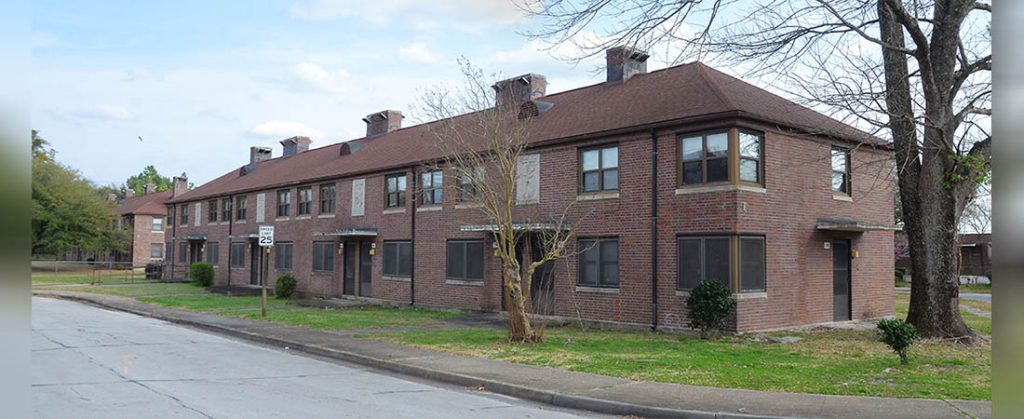
Nearly four and a half years after Hurricane Florence flooded New Bern’s Trent Court apartments, efforts to demolish the complex’s flood damaged buildings and procure funds for rebuilding efforts appear to be back at step one.
During the New Bern Housing Authority Board of Commissioners’ Feb. 20 meeting, the board heard from Valarie Philipp, an associate managing director with Witt O’Brien’s who specializes in FEMA public assistance grant management. Philipp, who began working with the housing authority last December, updated the board on what has transpired since Hurricane Florence in Sept. 2018 and where things stand with the housing authority’s FEMA grant process.
Overall, 108 of Trent Court’s 218 units were impacted by flood waters from Hurricane Florence. Twelve buildings at the site were permanently closed and recommended for demolition. The Housing Authority’s former office at Trent Court was also damaged beyond repair.
Since that time, the housing authority has worked with various state and federal agencies, including FEMA and HUD, to receive approval and funding for the demolition work and rebuilding at the site.
In 2019, a development firm involved in plans for the refurbishment of Trent Court, the Pennsylvania-based Pennrose Properties, pulled out of the venture due to a “high level of frustration,” according to former housing authority executive director Martin Blaney.
In July 2022, the city hired a company to perform an environmental review of the demolition area.
During the Feb. 20 meeting, Philipp told commissioners’ a handful of issues have caused delays in the funding and demolition process, including changes in the housing authority administration over the last several years. Current Executive Director Tiffany Askew came on board in June 2021. She took over from Tharesa Lee, who served as the housing authority’s interim director when Blaney stepped down in Feb. 2020.
“That has not helped because the historical knowledge of things that have transpired in the past have left, so it’s almost led to a need to start over every time there’s a change in administration,” Philipp said.
Philipp said staffing changes have also occurred within FEMA and state agencies that have slowed the process.
“Every time there’s a changeover in staff people are relying on looking at information that’s been collected in the FEMA grant portal online and other historical notes to try and see what’s going on and what direction they need to go,” she commented.
‘The buck has been passed’
Philipp said there has also been confusion about which entity, HUD or FEMA, should take charge of the process involving the implementation of funding and environmental reviews. She said going forward there would be a “multi-agency implementation” that would involve feedback from all agencies involved, with FEMA taking primary responsibility for funding.
“The buck has been passed around many times and even since I’ve been involved it’s been passed around,” she commented. “So, there’s some pushing off of those responsibilities to different agencies that are not taking responsibility. I believe that we’re trying to get on the correct path now,” she said.
Philipp admitted that in the past there had been no clear consensus on how to approach the demolition and reconstruction efforts.
“We have phone calls, we get on the same page with one agency and then a few days later we get an email that changes direction,” she noted. “So it’s been very difficult to try and round up everybody into one thought and have a consistent determination and process and a clear path to move forward.”
Philipp said various parties within FEMA seem to have “mixed up and misconstrued” what needs to happen in a FEMA project worksheet, which is meant to fund only the repair or replacement of the damaged Trent Court buildings. In the past, FEMA teams have confused that process with plans for the reconstruction of Trent Court’s Charles Taylor building and other issues, Philipp said.
“It really muddied the waters and made for a very convoluted, confusing project application process for the housing authority,” she noted.
Philipp said she feels there may have been some progress in the past few weeks, however, and thinks the entities involved now have a better understanding of the priorities of the city and the housing authority. She said once Trent Court’s damaged buildings are demolished a new housing authority administration building can be rebuilt on-site and a master plan can be created to address the future of the property.
“I believe we have a good state team and a good FEMA team on board at the moment. It doesn’t mean they will remain there but I think everyone understands the priorities and the path to getting projects obligated,” Philipp said.
Commissioner Zeb Hough said he had been “absolutely flabbergasted and frustrated” during a recent call with FEMA and thanked Philipp for her help in getting the process back on track.
Philipp said the demolition and funding process had gone “backwards to step one” and will take time to work through before it filters up to FEMA’s Consolidate Resources Center in Virginia, which will grant final approval for the project.
Phillip stressed that FEMA has received all the information that the housing authority was required to submit at this point.
“I do believe we will have the assistance of FEMA and the state to try to help that process move forward,” she said.
By Todd Wetherington, co-editor. Send an email with questions or comments.
Related article: Former elected officials appointed to New Bern Housing Authority Board — recap of Jan. 17 meeting

